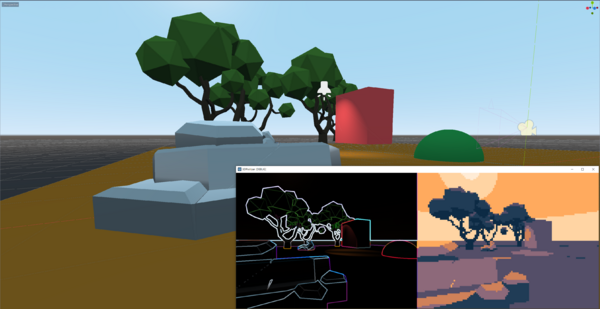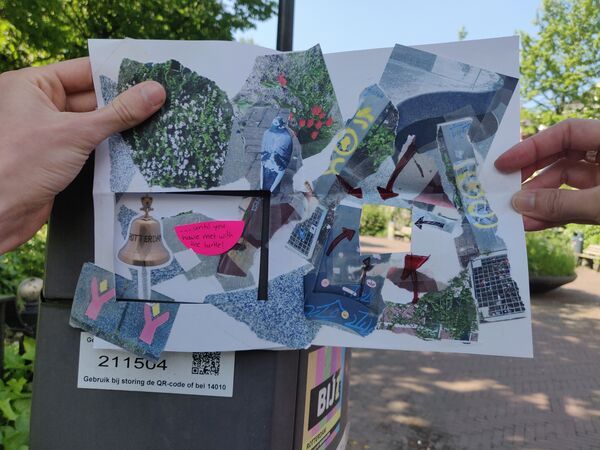User:Thijshijsijsjss/Gossamery/The Institute: Difference between revisions
(Add photos of photos) |
m (Remove a line for Gossamery consistency) |
||
| (6 intermediate revisions by the same user not shown) | |||
| Line 1: | Line 1: | ||
* Watched: 2024-04-25 | * Watched: 2024-04-25 | ||
* Watch it [https://www.youtube.com/watch?v=sK7myhXVyNU here] | * Watch it [https://www.youtube.com/watch?v=sK7myhXVyNU here] | ||
''The Institute'' is a 2012 documentary directed by Spencer McCall on the alternate reality 'Game of Nonchalance' initiated by Jell HHull that was ran from 2008 to 2011 in San Fransisco. This game featured a story centering around the concept of 'socio-reengineering', and focussed on shifting a the participants' perspectives on the everyday cityscape with a 'hidden-in-plain-sight wonderland'. The documentary is told as a retrospective, combining interviews from participants and creators with archival footage and new reconstructions. In particular, just like the game's ambiguous veracity, the film is created in such a way that the viewer can question how truthful its contents are. In fact, not having been part of this experience, the whole documentary could be a fabricated story. | |||
This documentary was shared by [[User:Louisa|Louisa]] as an extension to what we had been discussing during the [[SI24]] prototyping classes. [[SI24]] (on loitering and other forms of in-situ computation) focusses on activating the city, challenges our perception of our environment, and tries to critically reflect on the ways urban and social infrastructures influence each other. This very much resonates with ''The Institute''. In my personal practise, I am very interested in bringing interaction to static media, which is also much involved with changing perspective. Also using gaming and narrative devices. | |||
{|align=center | {|align=center | ||
| Line 8: | Line 10: | ||
|[[File:The-institute-viewfinder-2.png|thumb|Screenshot from the game Viewfinder]] | |[[File:The-institute-viewfinder-2.png|thumb|Screenshot from the game Viewfinder]] | ||
|} | |} | ||
One particularly exciting technique that was briefly shown in the documentary, was using a flyer / postcard to overlay with the city, highlighting a certain buyilding (see photo, compare to Viewfinder). This has the potential more much more applications, e.g. providing an alternative view on the postcard. I have been playing around with this idea for a while, for example in a game prototype I made that uses different shaders to reveal different parts of a landscape (see below). | |||
[[File:3d-pixilizer-shader-example.png|600px|thumb|center|alt=Screenshot within the Godot Game Engine featuring a 3d scene and two shader views|A 3d scene with two alternative shader views]] | |||
In the 2024-05-07 Prototyping class, in which we made an small alternate reality game in a single day, I explored this technique with Michel. | |||
[[File:20240507-prototyping-map.jpg|600px|thumb|center|alt=A sticker on a thrashcan in a park with a map put over it in such a way that the gap in the map lines up with the sticker|A map with two pieces cut out, one of which can be lined up with a sticker in the environment. The other gap then points to another location.]] | |||
'''Relevant links:''' | |||
* Wikipedia pages on [https://en.wikipedia.org/wiki/The_Jejune_Institute The Jejune Institute] and [https://en.wikipedia.org/wiki/The_Institute_(2013_film) the documentary] | |||
* [https://letterboxd.com/film/the-institute/ The Letterboxd page] | |||
* [[User:Vitrinekast|Rosa]] shared a link to [https://vimeo.com/6559514 this HKU 2008 graduation project] in response to ''The institute'' | |||
* [[User:Louisa|Louisa]] shared a link to [https://tzvetnik.online/article/unrealism-by-omsk-social-club-at-kunstraum-kreuzberg-bethanien-berlin this project] in response to [[User:Vitrinekast|Rosa]]'s link. | |||
Latest revision as of 12:26, 8 May 2024
- Watched: 2024-04-25
- Watch it here
The Institute is a 2012 documentary directed by Spencer McCall on the alternate reality 'Game of Nonchalance' initiated by Jell HHull that was ran from 2008 to 2011 in San Fransisco. This game featured a story centering around the concept of 'socio-reengineering', and focussed on shifting a the participants' perspectives on the everyday cityscape with a 'hidden-in-plain-sight wonderland'. The documentary is told as a retrospective, combining interviews from participants and creators with archival footage and new reconstructions. In particular, just like the game's ambiguous veracity, the film is created in such a way that the viewer can question how truthful its contents are. In fact, not having been part of this experience, the whole documentary could be a fabricated story.
This documentary was shared by Louisa as an extension to what we had been discussing during the SI24 prototyping classes. SI24 (on loitering and other forms of in-situ computation) focusses on activating the city, challenges our perception of our environment, and tries to critically reflect on the ways urban and social infrastructures influence each other. This very much resonates with The Institute. In my personal practise, I am very interested in bringing interaction to static media, which is also much involved with changing perspective. Also using gaming and narrative devices.
One particularly exciting technique that was briefly shown in the documentary, was using a flyer / postcard to overlay with the city, highlighting a certain buyilding (see photo, compare to Viewfinder). This has the potential more much more applications, e.g. providing an alternative view on the postcard. I have been playing around with this idea for a while, for example in a game prototype I made that uses different shaders to reveal different parts of a landscape (see below).
In the 2024-05-07 Prototyping class, in which we made an small alternate reality game in a single day, I explored this technique with Michel.
Relevant links:
- Wikipedia pages on The Jejune Institute and the documentary
- The Letterboxd page
- Rosa shared a link to this HKU 2008 graduation project in response to The institute
- Louisa shared a link to this project in response to Rosa's link.




